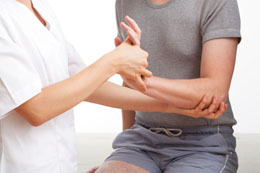Compressed median nerve near the elbow is responsible for the development of pronator teres syndrome which is more common in people belonging to the age group 40 - 50. Read on to know more on the causes of the syndrome and how it is treated.

The median nerve which runs through the forearm and the hand, can get compressed at various spots along its path. Carpal tunnel syndrome (CTS) which involves compression of the median nerve at the wrist is more common than pronator teres syndrome (PTS) which develops as a result of the compressed median nerve near the elbow.
PTS Causes
The median nerve can get compressed at the elbow or in the proximal part of the forearm; when the pronator teres muscle exerts pressure on it. The nerve usually gets pressed between the two heads of the muscle, mainly due to the repetitive motions of the hand. Pronator teres muscle plays an important role in actions like turning the palm downward or behind you or away from you. Entrapment of the nerve takes place due to repetitive use or overuse of this muscle. Certain occupations demand repetitive movements, for example, hammering or continuous use of tools by a carpenter, overhand motions in sports like tennis, badminton and motions of a baseball batter. Excessive exercise can lead to PTS. Muscle hypertonicity can lead to pinched median nerve. Similarly, development of fibrous bands within the muscle can result in compressed median nerve. Certain structural abnormalities; or excessive pressure on the nerve by other structures in the arm, like the ligament of Struthers or the thickening of the bicipital aponeurosis (lacertus fibrosus) can result in entrapment of the median nerve in the region of the elbow and can lead to pronator teres syndrome.
PTS Symptoms and Test
As the median nerve in the upper extremities is responsible for sensation in the skin of the palm, thumb, index, middle finger, half the ring finger and the bones of the wrist; entrapment of the nerve would not only show symptoms near elbow and forearm but also in the hand. Most of the symptoms are similar to the symptoms of carpal tunnel syndrome, because the same nerve is involved in both the cases. Pain and tingling sensation in the forearm, palm and fingers are the commonly noticed symptoms of PTS. You may experience restricted movement of the fingers or stiff fingers, as the signals from the brain would not pass through the compression point. People suffering from CTS often complain about night pain but those with PTS usually don't. People diagnosed with PTS do not experience worsening of symptoms during night. Wrist movement usually does not aggravate PTS symptoms. Similarly pain due to PTS is experienced in the forearm. CTS does not cause pain in the forearm.
The simple pronator teres test helps diagnose PTS. You will be asked to stand and fold your arm making an angle of 90 degrees at the elbow. The doctor will support your elbow with one hand and with another hand, he will try to turn your forearm slowly, in such a way that the pronator muscles would contract. If you have pain or discomfort, it suggests that the median nerve is compressed between the pronator muscle heads. An EMG (electromyogram) test which involves mild electric shocks and needle pricks helps know about the nerve damage in case of pinched nerve.
PTS Treatment
As PTS involves compression of the nerve between the muscle, massage therapy helps relieve the symptoms of PTS. Accurate diagnosis helps to identify the proper region for the massage. Massage therapy helps release and lengthen the pronator teres muscle. Certain exercises, physiotherapy, helps get rid of the PTS symptoms. In extreme cases, surgery is recommended. Almost 50% patients diagnosed with PTS recover within 4 months with various therapies. Proper massage and exercises prevent the situation from worsening. But some patients may take 18 months to 2.5 years to recover after such treatment. They need to provide sufficient rest to the affected nerve and muscle. Surgery often involves relieving pressure on the nerve at all possible sites along the path of the nerve.
Correct diagnosis plays an important role in fast recovery from pronator teres syndrome. Whether the pain in the palm and the fingers is due to CTS or PTS, it has to be determined by the doctor. Then only, proper treatment can be planned. So, if you notice pain in the forearm and hand, you should immediately consult your doctor.


 The median nerve which runs through the forearm and the hand, can get compressed at various spots along its path. Carpal tunnel syndrome (CTS) which involves compression of the median nerve at the wrist is more common than pronator teres syndrome (PTS) which develops as a result of the compressed median nerve near the elbow.
The median nerve which runs through the forearm and the hand, can get compressed at various spots along its path. Carpal tunnel syndrome (CTS) which involves compression of the median nerve at the wrist is more common than pronator teres syndrome (PTS) which develops as a result of the compressed median nerve near the elbow.